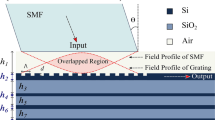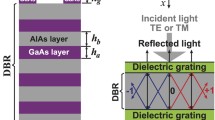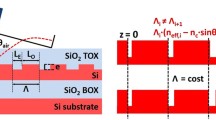Abstract
A pair of identical grating couplers can be used to transmit/receive optical signals between vertically separated optical waveguides. We propose a silicon-based grating coupler with an integrated distributed Bragg reflector (DBR) to improve the light coupling bandwidth and efficiency. The optimized grating coupler structure and DBR position were developed using the finite-difference time-domain method. We numerically analyzed the coupling efficiency and bandwidth performance, and the proposed grating coupler structure achieved a theoretical peak coupling efficiency of 0.824 and a 1 dB bandwidth of 157.2 nm at close to 1550 nm, both of which represent improvements of more than two-fold compared with those of conventional grating couplers without a DBR layer.
Similar content being viewed by others
References
D. A. B. Miller and H. M. Ozaktas, J. Parallel Distrib. Comput. 41, 42 (1997).
D. A. B. Miller, IEEE J. Sel. Top. Quant. Electron. 6, 1312 (2000).
D. A. B. Miller, Proc. IEEE 97, 1166 (2009).
S. Bernabé et al., Opt. Exp. 20, 7886 (2012).
J. Kang et al., Jpn. J. Appl. Phys. 51, 120203 (2012).
K. Itoh et al., IEEE J. Sel. Top. Quan. Electron. 22, 4403209 (2016).
A. V. Krishnamoorthy et al., IEEE J. Quan. Electron. 45, 409 (2009).
J. E. Cunningham et al., IEEE J. Sel. Top. Quan. Electron. 17, 546 (2011).
X. Zheng et al., J. Lightw. Technol. 30, 641 (2012)
A. V. Krishnamoorthy et al., Proc. IEEE 97, 1337 (2009).
W. Bogaerts et al., IEEE J. Lightw. Technol. 23, 401 (2005).
X. Zheng et al., Opt. Exp. 16, 15052 (2008).
P. Sun and R. M. Reano, Opt. Exp. 19, 4722 (2011).
J. Yao et al., Proc. SPIE 7944, 794405 (2011).
Y. Kuno et al., Jpn. J. Appl. Phys. 54, 04DG04 (2015).
M. H. Lee et al., J. Opt. Soc. Korea 20, 291 (2016).
M. Asaduzzaman et al., Opt. Quan. Electron. 45, 478 (2016).
A. Mekis et al., IEEE J. Sel. Top. Quan. Electron. 17, 597 (2011).
D. Taillaert et al., IEEE J. Quan. Electron. 38, 949 (2002).
X. Chen et al., IEEE Photon. Technol. Lett. 22, 1156 (2010).
T. K. Gaylord and M. G. Moharam, Proc. IEEE 73, 894 (1985).
Q. Zhong et al., Opt. Exp. 22, 18224 (2014).
M. K. Emsley, O. Dosunmu and M. S. Ünlü, IEEE J. Sel. Top. Quan. Electron. 8, 948 (2002).
H. Zhang et al., Opt. Exp. 22, 21800 (2014).
Author information
Authors and Affiliations
Corresponding author
Additional information
A correction to this article is available at http://dx.doi.org/10.3938/jkps.71.1075
Rights and permissions
About this article
Cite this article
Hong, YS., Cho, CH. & Sung, HK. Theoretical analysis of simultaneously improving the light coupling efficiency and bandwidth between two separated grating couplers using integrated distributed Bragg reflectors. J. Korean Phys. Soc. 71, 647–651 (2017). https://doi.org/10.3938/jkps.71.647
Received:
Published:
Issue Date:
DOI: https://doi.org/10.3938/jkps.71.647




